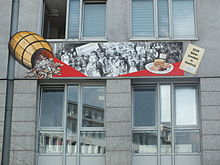Aspic riots

The brawn riots , also known as the Hamburg brawn uprising , occurred in Hamburg in late June 1919 . The trigger was the assumption by the population that rotten carcasses would be processed into brawn and sold. As a result of the unrest, the Reichswehr and Freikorps marched into the Hanseatic city.
procedure
The political mood in Hamburg in June 1919 was tense: the events and tensions of the November Revolution were still having an effect, the Bavarian Soviet Republic had been bloody destroyed shortly before. While workers feared for the gains of the revolution and felt exposed to armed counterrevolution, the bourgeoisie and commerce worried about public safety and feared insurrection and anomie .
The conflict broke out in Hamburg when, on June 23, 1919, a barrel with rotten carcasses broke in front of the Heil Fleischwarenfabrik (which was actually a tannery and whose owner tried to benefit from the prevailing need, which was also helped by the renaming) in the Kleine Reichenstrasse . The crowd, who had gathered, suspected that the carcasses were being processed into brawn in the factory and stormed the premises, where they found more carcasses of rats , dogs and cats . The fact that waste for glue factories was also collected in the factory was unknown to the amount applied (and should have been separated cleanly at that time): But this could not be clarified. The factory owner himself was thrown into the Kleine Alster and only narrowly escaped death.
In the days that followed, crowds searched various other meat factories and found many signs of meat adulteration . On the morning of June 24, 1919, stinking carcass waste was found at the Starck & Co. company, as was the Roßkamp & Staack company in Hohenfelde. The unrest spread over the city and also spread to the neighboring Altona . Not only the factory owners, but also government agencies, accused of complicity, were victims of violent attacks.
The first escalation occurred at the Rathausmarkt . After a " pillory " had been set up for various suspects, the town hall guard tried to intervene. Shots rang out, a detachment of temporary volunteers hated by the workers marched, a hand grenade exploded and the town hall was besieged.
In the days that followed, Reichswehr Minister Gustav Noske declared the execution of the Reich and instructed Major General Paul von Lettow-Vorbeck , who later participated in the Kapp Putsch , to put down the unrest. When Reichswehr troops marched into the now largely quiet city on June 27, the soldiers were persuaded to turn back when the actual situation in Hamburg was described to them. On July 1, 1919, however, Reichswehr and Freikorps troops, including volunteer associations from Altona , marched into the city. They occupied the workers' living quarters, in many places they hoisted the black-white-red flag of the empire , workers and functionaries were often arrested and mistreated under arbitrary accusations, the Freikorps made generous use of their firearms to strike down "looters and snipers" the quarters a "rapid justice" by the troops.
effect
In the long term, the uprising led to a redistribution of the military balance of power in the city. While, on the one hand, the “People's Army”, which originated from the time of the revolution, was dissolved, the bourgeois and often anti-republic temporary volunteer associations and resident services were strengthened. In addition, a militarily equipped and partly barracked security police was created, the members of which were largely composed of former professional soldiers and members of the voluntary corps.
There were 80 fatalities. The meat manufacturer Heil was found guilty by the court of producing brawn from calf's scalp in questionable condition - mushy, moldy and covered with maggots - and that his business obviously did not meet the hygienic requirements. On October 25, 1919, he was sentenced to three months in prison and a fine of 1,000 Reichsmarks.
Today a plaque in the Hamburg town hall and a mural on the facade of the building of the Hamburg consumer center remind of the unrest and the consequences of this early food scandal .
literature
- Jörg Berlin: State guardian and revolutionary advocate. Workers' parties in the post-war period. In: Ulrich Bauche u. a. (Ed.): “We are the force.” Labor movement in Hamburg from its beginnings to 1945. Catalog book for exhibitions at the Museum of Hamburg History. VSA, Hamburg 1983, ISBN 3-87975-355-5 , pp. 103-131.
- Sven Philipski: Food shortage and social protest: The Hamburg brawn riots in 1919. (PDF; 2.9 MB) Master's thesis, Hamburg 2002. Published by the Heinrich Kaufmann Foundation , Hamburg 2010, ISBN 978-3-8-3918-100-3 .
- Uwe Schulte-Varendorff: The hunger riots in Hamburg in June 1919 - a second revolution? (= Association for Hamburg History (Hrsg.): Contributions to the history of Hamburg. Vol. 65; PDF; 8.7 MB). Hamburg University Press, Hamburg 2010, ISBN 978-3-937816-63-0 .
Web links
- Johanna Lutteroth: Food scandal 1919: Schuld und Sülze , Spiegel Online , accessed February 6, 2018.
- Hamburg picture archive: pictures of the brawn riots
Individual evidence
- ↑ Sven Philipski: Food shortage and social protest ..., p. 57.
- ^ Johanna Lutteroth: Food scandal 1919: Schuld und Sülze one day on Spiegel Online , accessed on February 6, 2018
- ↑ Hamburger Abendblatt of June 24, 2015: "First World War in Hamburg: How the dog got into the brawn"